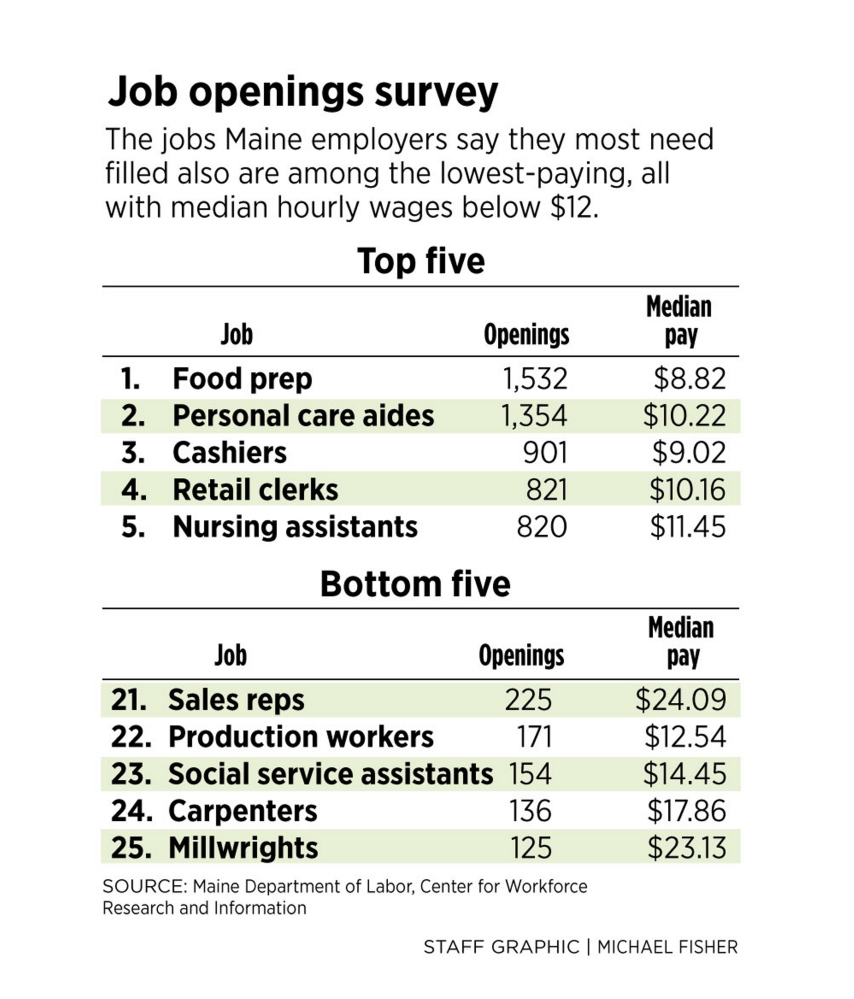Low-paying jobs such as food service workers and personal care aides topped the list of occupations in highest demand among Maine employers, according to a survey of businesses conducted by the Maine Department of Labor’s Center for Workforce Research and Information.
The top five jobs Maine employers most needed filled all paid a median hourly wage of less than $12, according to a report on the survey results available online at cwri.blogspot.com. Those five occupations, which also included cashiers, retail clerks and nursing assistants, represented 25 percent of all available jobs, the report said.
“The distribution of vacancies by wages was certainly lower than we’d like to see,” said Ruth Pease, economic research analyst for the center.
The industries seeking to fill the greatest number of jobs in Maine were health care and social assistance, retail, food service and “administrative and waste services,” a diverse category that includes temp agencies and waste management firms.
The survey was conducted by mail, online and by telephone, and was sent to 3,400 workplaces during the fall of 2014. The center received nearly 2,400 responses, with 755 employers citing at least one job opening, the report said.
Employers were asked to report openings for which they were actively recruiting in September. They were asked to provide the number of jobs, their titles, whether they were full or part time (fewer than 35 hours per week) and other job characteristics or requirements, the report said.
“This is a snapshot in time from last September,” Pease said, adding that the last time the survey was conducted was in 2009. “We’re hoping to make this an annual event.”
Those taking the survey reported a total of 21,520 job openings, a vacancy rate of 4 percent, or four job openings per 100 jobs. About 62 percent of available jobs were full time, and 12 percent were seasonal or temporary, they said.
The five most in-demand occupations all paid a median wage of less than $12 an hour. At the top of the list was “combined food preparation and serving workers, including fast food,” for which there were 1,532 vacancies. Only 16 percent of the openings were for full-time jobs, and the median hourly wage, based on 2013 data, was $8.82.
Personal-care aides were a close second, with 1,354 openings reported. The median hourly wage for such jobs was $10.22, and 52 percent were full time. There were 902 openings for cashiers (20 percent full time with a median hourly wage of $9.02), 821 for retail salespeople (37 percent full time with a median hourly wage of $10.16) and 820 openings for nursing assistants (59 percent full time with a median hourly wage of $11.45).
“While there were nearly 400 individual occupations with at least one identified job opening, (those) five occupations account for one quarter of total vacancies,” the report said.
The highest-paying job for which employers reported a high number of vacancies was registered nurses. There were job openings for 658 nurses in September, 72 percent of which were full-time jobs. The median wage for a registered nurse in Maine was $29.66 in 2013.
Pease said the survey results held few major surprises, but there was one big one: the overall difficulty employers reported they were having in their efforts to fill job vacancies.
For each reported opening, the survey-takers were asked to rate whether they were having difficulty filling it. The employers responded “yes” for 70 percent of all jobs.
“I was really surprised that there were so many,” Pease said.
The industries with the highest share of tough-to-fill positions were natural resources (97 percent); professional, scientific and technical services (95 percent); and construction (94 percent). The industry with the easiest time filling available job vacancies was arts, entertainment and recreation, with just 35 percent of jobs being difficult to fill.
Equally surprising is that despite the high degree of challenge associated with filling open jobs, it has not led to wage increases in Maine among the occupations with the highest demand, Pease said.
“We haven’t seen as much (upward) pressure on wages as the laws of supply and demand suggest we might have,” she said.
Send questions/comments to the editors.





Success. Please wait for the page to reload. If the page does not reload within 5 seconds, please refresh the page.
Enter your email and password to access comments.
Hi, to comment on stories you must . This profile is in addition to your subscription and website login.
Already have a commenting profile? .
Invalid username/password.
Please check your email to confirm and complete your registration.
Only subscribers are eligible to post comments. Please subscribe or login first for digital access. Here’s why.
Use the form below to reset your password. When you've submitted your account email, we will send an email with a reset code.